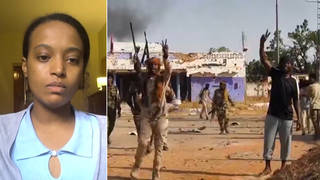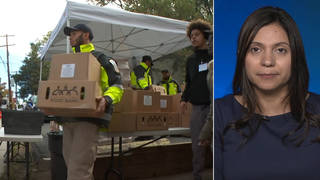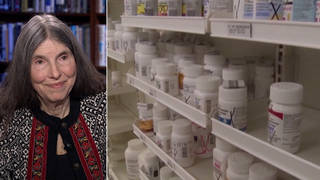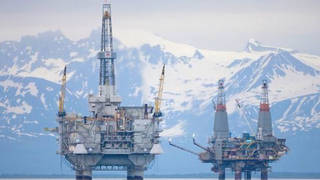
Guests
- Ben Stewartjournalist and climate activist. In 2010, he led the first Greenpeace expedition to challenge Arctic oil drilling off the Greenland coast. In 2013, he was a leading figure in the campaign to free the Arctic 30. His new book is titled Don’t Trust, Don’t Fear, Don’t Beg: The Extraordinary Story of the Arctic 30.
- Peter Willcoxhas worked with Greenpeace for more than 30 years. He was captain of the Greenpeace Arctic Sunrise ship and spent two months in detention in Russia as a member of the Arctic 30. In 2014, he received a Lifetime Achievement Award from The Guardian for his environmental activism.
The Arctic is now the center of one of the world’s great environmental battles. As temperatures rise in the region, the world’s largest oil companies are eyeing vast new untapped reserves once covered year-round by ice. Environmentalists are pushing back in an attempt to save the pristine Arctic and keep the oil underground. We look back at a 2013 protest that caught the world’s attention, when activists from Greenpeace attempted to board a Russian oil drilling rig owned by the Russian state oil company Gazprom. In total, 28 Greenpeace activists and two journalists were arrested and brought to Russia, where they were charged with piracy and held for two months. They had faced up to 15 years in prison. They became known as the Arctic 30. We are joined by two guests: Peter Willcox, the captain of the Greenpeace ship involved in the action who spent two months in a Russian jail; and Ben Stewart, a longtime member of Greenpeace and author of the new book, “Don’t Trust, Don’t Fear, Don’t Beg: The Extraordinary Story of the Arctic 30.”
Transcript
AARON MATÉ: We turn now to the Arctic, the center of one of the world’s great environmental battles. As temperatures rise, the world’s largest oil companies are eyeing vast new untapped reserves once covered year-round by ice. Environmentalists are pushing back in an attempt to save the pristine Arctic and keep the oil underground. Protesters in Seattle recently staged days of action against Royal Dutch Shell’s plan to resume oil exploration in the Arctic. Last month, the Obama administration gave conditional approval to Shell’s resumption of fossil fuel exploration in the Arctic.
But today we look back at a 2013 protest that caught the world’s attention. That’s when activists from Greenpeace attempted to board a Russian oil drilling rig owned by the Russian state oil company Gazprom. What happened next is chronicled in the documentary Black Ice.
DIMA LITVINOV: We believe that your platform and the activities being carried out in preparation for drilling for oil in the Arctic Ocean represents a real and immediate threat to the environment both here and globally.
FRANK HEWETSON: We started being chased everywhere we went, everywhere we tried to get a line up. We only had a few minutes within which to get climbers up underneath that heavy platform. But it was a chase, and we were losing time rapidly.
SINI SAARELA: I managed to get a rope up, and I started to climb up on it. But just when I was attaching myself to the rope, the Coast Guard boat came and started pushing our boat away.
FRANK HEWETSON: They realized we were going to continue, and we were going to try our hardest to get a climber onto that rig. And they had made a decision that was not going to happen. And they drew guns, and they pointed it straight in my face.
Sunrise, gun pointed straight in our faces. Two guns pointed directly at our faces.
DENIS SINYAKOV: I used to be a war photographer in the Reuters and Agence France-Presse. And when I saw these aggressive soldiers, I knew the main point now is not only the hanging the banner, but I had to take photos how they pointed the gun at the Greenpeace activists.
SINI SAARELA: It was such a bizarre thing to see a gun pointing at you, that I maybe couldn’t even take it seriously, because it just felt so wrong. We were there during a peaceful protest. We were not threatening anyone or anything, and they come there with their guns.
AARON MATÉ: Two of the Greenpeace activists were detained aboard the Russian oil rig. A day later, Russian special forces raided the Arctic Sunrise. This is another excerpt from Black Ice.
DIMA LITVINOV I was sitting in the mess, I remember—I think we were just finishing up lunch—when I heard a lot of screaming and running around in the corridors outside, people shouting, “Helicopters coming! Helicopters coming!” I went out on deck, and from that moment on, I was in the middle of a James Bond movie.
PETER WILLCOX: Well, when the boarding happened, I was actually down on an exercise machine in the hold, and I heard the engine stop. And about a minute later, some panic-stricken crew member came running up and, “God, oh, my god, they’re jumping out of a helicopter!” I thought, “Oh.”
DIMA LITVINOV I went out on the helideck, and I saw the first of this masked, camouflage-clad, heavily armed troopers slide down the wire onto the deck of the Arctic Sunrise, started shouting at us in Russian, telling us to “Get down! Get down on the deck!” Guns were being pointed more or less in the direction of the people. I turned around, and I ran for the bridge. As I was running up the steps, I saw Frank standing in front of the door, and I saw him being pulled back and thrown down to the ground by another trooper. I stopped in front of his body, and then I felt a hand on my shoulder, pulling me back and then shoving me forward, and I stumbled and fell onto Frank’s prone body.
AMY GOODMAN: In total, 28 Greenpeace activists and two journalists were arrested and brought to Russia, where they were charged with piracy and held for two months. They faced up to 15 years in prison. They became known as the Arctic 30.
Well, today we’re joined by two guests. Peter Willcox was the captain of the Greenpeace ship, the Arctic Sunrise. He spent two months in a Russian jail, legendary figure in the environmental world, was also captain of Greenpeace’s Rainbow Warrior, which was blown up by the French government, two French secret service agents 30 years ago killing the photographer Fernando Pereira. Also with us, Ben Stewart, longtime member of Greenpeace, who led the first Greenpeace expedition to challenge Arctic oil drilling off the Greenland coast. He’s author of the new book, Don’t Trust, Don’t Fear, Don’t Beg: The Extraordinary Story of the Arctic 30. He was a leading figure in the campaign to free the Arctic 30.
So, Peter Willcox, talk about what happened next. So we see what happens on the boat. Talk about what happens when you’re taken off to prison. How were you taken?
PETER WILLCOX: We arrived in Murmansk late one afternoon. We were met by a number of embassy officials. And then we were told to—
AMY GOODMAN: How many different countries did the Greenpeace activists come from?
PETER WILLCOX: I think there were 18 different countries that we represented. I’m not sure if everybody’s consular official was there. Mine certainly was there from St. Petersburg, the U.S. consular.
AMY GOODMAN: From Florida.
PETER WILLCOX: I guess so. I’m not—I can’t remember. But he was worried. I was—at that point, I was like, “Look, we’ve been arrested. We’ve done this before.”
AMY GOODMAN: Meaning your consular was from St. Petersburg, Russia.
PETER WILLCOX: Yes.
AMY GOODMAN: Ah.
PETER WILLCOX: Sorry.
AMY GOODMAN: But it was the U.S. consul.
PETER WILLCOX: Yes, it was the U.S. consul who—the consulate is in St. Petersburg. The embassy is in Moscow. And they—as far as we were concerned, it was all business as usual. We’d been arrested in Russia before. My first campaign there was in '83. It's all going to plan. The things didn’t start to get exciting until we got into the investigator’s office that evening, and they said, “Well, you’re not going back to the boat. You’re being arrested. You’re being sent to detention for two months. And we’re charging you with piracy, which is 10 to 15 years.” And that was a little disconcerting.
AMY GOODMAN: So, you’re watching this, Ben.
BEN STEWART: Yeah.
AMY GOODMAN: You’re not in this action.
BEN STEWART: No.
AMY GOODMAN: But you’re the communications director.
BEN STEWART: Yeah.
AMY GOODMAN: What are you thinking at this point? Where were you?
BEN STEWART: Well, I was in London, and it’s the same as what Pete said: We thought this was a standard Greenpeace action. It had been pretty good. There had been some good footage. There had been some media attention. The presumption was that those guys would get kicked out of the country and be telling their stories in a bar in Norway that evening. We got the news when Denis, who was just on that film, went to court. And it was a shock to him. It was a shock to all of us. They were being charged with piracy, minimum 10 years in a country where 99 percent of people that go to trial get found guilty. And suddenly, for us, this became a humanitarian crisis. We had 28 activists and two journalists there, and we thought that we were going to lose them into Russia’s new Gulag system for the next 10 to 15 years.
AMY GOODMAN: Well, on that point of being in the Gulag system, can you talk about the conditions for these activists when they were in prison?
BEN STEWART: Well, for the book, I interviewed about 16 or 17 of them when they got out. The truth is that they didn’t have it as bad as many of the Russian prisoners. I think that Putin realized that if these guys were maltreated, it would be bad for Russia’s reputation. Some extraordinary things happened in jail. I spoke to Dima, who was on there, who told me how, effectively, the Arctic 30 were taken under the wing of some of the prisoners, some of the mafia bosses. The Kotlivaya [phon.], who controlled the place, actually decided that the Arctic 30 had been the subject of a gross injustice by Putin, and so, in a sense, they were kind of protected.
They were given access to this extraordinary communication system in the jail, called the doroga, which translates as “the road,” which is a kind of physical prison Internet. Each evening, the prisoners would get ropes out and string them up, down, left and right, outside their window, and create a grid system, and then they put socks on that rope and exchanged what they called emails, which were little messages—you know, “423 Dima, how are you doing?” And it will go off. And they’d exchange sugar and cigarettes and all these kind of things. And this doroga was how the mafia bosses dispensed justice and controlled the prison.
AMY GOODMAN: And explain. I mean, you describe this at the beginning of the book, the piping system within the jails, how it’s used to communicate.
BEN STEWART: It’s used as a prison telephone system. And Frank Hewetson, who again was in the film that you showed there, told me how he was lying there one night, and one of his cellmates called him off his bunk, and Frank went down, and the guy pulled off the U-bend from the toilet and put it—
AMY GOODMAN: The U-bend, in the pipe—
BEN STEWART: The U-bend. And put it to Frank’s ear, and Frank heard his friend, Roman Dolgov, saying, “Frank, Frank, can you hear me?” And they had a conversation and realized that this is how the prisoners communicated with each other. And I think this shows, actually, how important human contact is to people to survive. Lots of these guys in there had done very, very bad things on the outside, but they were human beings. And their way of living was to communicate. It was as important as food and water to them.
PETER WILLCOX: Remember, too, Ben, that in the detention, you’re in—isolated in your cell for 23 hours a day.
AMY GOODMAN: How many people were with you?
PETER WILLCOX: One, sometimes none. Some people had two cellmates. You’re taken for an hour to a bigger cell to get to walk around and get a little exercise, supposedly. But it really was isolation. I mean, you weren’t—there wasn’t a—you didn’t eat with your other prisoners. You didn’t see your other prisoners. So the communication at night was a fundamental thing.
BEN STEWART: And the women were kept in—there were eight women in the Arctic 30. They were kept in solitary confinement. And they worked out how to communicate by developing a code. They would tap on a radiator pipe that went through all of their cells with a spoon. One tap meant A; two, B; three, C. And they showed me their notebooks when they got out of jail, and they were full of these conversations, each sentence about the length of a tweet. But it would take 20 minutes to tap it out. And by the end of it, they knew each other so well. They had only been with each other 11 and 12 days on the ship. But when they got out, they were so close, because they knew everything about their families, boyfriends and everything, merely by this code tapping away. And again, I think, in an era of instant communication with tweeting, it shows something important about the importance of communication, by using that spoon on that radiator pipe.
AMY GOODMAN: So we’re going to break and then come back to the discussion about why you were doing what you were doing, Peter and Ben, as the communications director. Again, Ben Stewart’s book, Don’t Trust, Don’t Fear, Don’t Beg: The Extraordinary Story of the Arctic 30. This is Democracy Now! Back with them in a minute.
[break]
AMY GOODMAN: Bonnie “Prince” Billy, “Black Captain,” revised for Peter Willcox, who is our guest today. That’s right, we’re joined by Peter Willcox and Ben Stewart, who wrote Don’t Trust, Don’t Fear, Don’t Beg: The Extraordinary Story of the Arctic 30. I’m Amy Goodman, with Aaron Maté.
AARON MATÉ: As we turn to some of the voices of the Arctic 30, these are excerpts of letters they wrote while imprisoned in Murmansk. Greenpeace produced this video, featuring a dramatic reading of their letters.
ALEX: Dear James.
PO PAUL: Dear supporters. It’s been over a month now that the “special forces” dropped by helicopter and took over our ship at gunpoint. Quite a terrifying moment, I must admit, surreal, out of an Action movie. Since then life has been quite difficult.
FRANK: We were towed into port under armed guard, Murmansk being the final destination.
ALEX: When we were taken off the ship to be arrested, it felt like a scene from the Cold War. It was dark. I was scared.
KIERON: The hardest moment was the first night in prison, being shown to my cell and introduced to a couple of strangers. It was frightening, to say the least. The cell is about eight meters long, four meters wide and six meters high. I spend 23 hours a day in here, without nothing but the occasional book and my thoughts.
PO PAUL: The weather has turned to winter.
FRANK: Everyone sleeps with their clothes on.
ALEX: I heard that from December, Murmansk is dark for six weeks. God, I hope I’m out by then.
AMY GOODMAN: Voices of the Arctic 30. Ben Stewart, do you think Greenpeace adequately prepared for the potential of this harsh Russian crackdown? And how did Greenpeace respond after it became clear that the activists were not going to be released?
BEN STEWART: OK, so two questions there. I think the first one, that’s a very fair question. Greenpeace has been asked it a lot. Were they naive to go up there and not imagine that Putin’s judicial system would come down really hard? And I think opinion is split, to be honest. I mean, some of the Arctic 30 think that Greenpeace really should have known and should have predicted it. Others say, no, that’s not true; Greenpeace went up a year before and did a similar protest and didn’t get this kind of reaction.
AMY GOODMAN: I mean, we had Kumi Naidoo on the phone here—
BEN STEWART: Yeah.
AMY GOODMAN: —in the Democracy Now! studio, broadcasting live as he was being pummeled with the Arctic water that they were shooting at him—
BEN STEWART: Yeah.
AMY GOODMAN: —in cannons, hanging off the side of the ship, and he is the head of Greenpeace.
BEN STEWART: And that was exactly a year before the events that we’re talking about here, and there wasn’t this Russian reaction. Then, a year later, this huge Russian overreaction. So, I don’t think I’m qualified to say whether Greenpeace was naive or not. There’s split opinion on it.
The second question, like what was Greenpeace’s reaction? Well, we immediately went into crisis mode. Everybody in the organization was put on the job of getting these guys out of jail. We immediately realized that we were in some kind of geopolitical chess game with Putin. And to be honest, we felt a bit out of our depth. We were advised by senior analysts who said, “Don’t make Putin the focus of this. If you blame it all on Putin, then he’s going to feel cornered, and his pride won’t let him release them.” And he says that that’s the mistake that the lawyers for Pussy Riot made. We had to give Putin, quote, “a wide turning circle.” So we made Gazprom, his energy company, the focus of the campaign—in a sense, a proxy for Putin—and went after Gazprom and kicked them as hard as we could.
AMY GOODMAN: And explain what Gazprom was doing.
BEN STEWART: Gazprom was up there, 200 miles north of the Arctic Circle, with this rig that we saw in the images there, the Prirazlomnaya oil rig. They were trying to be the first company to pump oil from the icy waters of the Arctic, and therefore spark a new Arctic oil rush. Greenpeace’s position was that we have to keep the oil in the ground; we can’t be looking for new sources of oil and exploiting them. So this, at that point, was the most controversial oil rig in the world, and that’s why these guys planned to hang a one-ton survival pod off it and focus attention on that rig by having people live in the pod for days, maybe weeks. And then we saw these events that you saw in the film, the massive overreaction, shots fired, and these guys dragged off to prison for 15 years.
AMY GOODMAN: And the issue of why the focus on the Arctic? This is 13 percent of the world’s untapped oil. Can you give us a layout of just what’s at stake here, with the risks of drilling and how much energy we’re talking about?
BEN STEWART: Well, two things. I mean, there’s a supreme irony here that as the ice melts, oil companies, instead of seeing it as a profound warning to humanity, they’re saying, “Right, we have an opportunity to get our hands on the oil and gas that used to be under the ice.” So they’re going there to drill for the oil that caused the melting. When they burn it, it will cause more melting, so they can drill for more oil. This is a vicious circle, and Greenpeace was up there to try to break that circle. As well as that, it would be impossible to clean up an Arctic oil spill. You saw what happened with Deepwater Horizon. It took 6,500 boats to clean that up. You can’t get that kind of response up in the Arctic.
PETER WILLCOX: And they didn’t clean it up, Ben.
BEN STEWART: And they didn’t clean it up.
PETER WILLCOX: Yeah.
BEN STEWART: You know, and then, also, as the ice returns in the winter, it would stop them actually drilling a relief well, so that oil would pump, if there was a blowout up there, for month after month, collecting under the ice and then circulating around the pole. We got Shell’s oil spill response plan through Freedom of Information, and it showed that one of the methods that they had planned for cleaning up an oil spill was to deploy a dachshund dog called Tara with a GPS collar that was supposedly going to sniff out the ice. They would then remove the icebergs and melt them on land and take the oil out. This is a fantasy. And that’s why there’s a big focus on Seattle at the moment, where there are plans for Shell to send the Polar Pioneer rig up to the Alaskan Arctic. So, really, America is the focus of this Arctic campaign now, and there’s some fantastic stuff happening in Seattle.
AMY GOODMAN: And G7, what just came out of it, your assessment, as people hail this as groundbreaking around the issue of climate change?
BEN STEWART: Well, they say they’re going to phase out fossil fuels by 2100. Great, about 70 years too late. I think we’ll be toast by then.
AMY GOODMAN: Peter Willcox, the issue of Seattle right now, the kayaks that are coming out, politicians in them, activists—Greenpeace is also at the center of this—the protesting of Shell drilling in the Arctic?
PETER WILLCOX: Yeah, I think it’s becoming obvious to more and more people that if we burn even a quarter of the fossil fuels we have in hand now, we’ll push global warming up past the two degrees Celsius mark, which some scientists say is just a recipe for disaster. We’ve already changed it 0.8 degrees. If we stopped burning all fossil fuel tomorrow, it would still go up another 0.8 degrees. So we’re sniffing two degrees Celsius change, and there are already people are dying from global warming. And when the waters come up—I mean, India has just built a massive electric fence between itself and Bangladesh, because they don’t want the people from Bangladesh trying to get into India when the waters rise. I mean, it’s a huge problem. And there is no excuse for oil companies to be looking to make more profit from something that we can never use. It’s a huge waste of energy.
AARON MATÉ: What’s striking about the Shell decision, the recent approval, is the Interior Department a few months ago says there’s a 75 percent likelihood of a spill of 1,000 barrels or more in the Arctic offshore region. So the government’s own assessments say 75 percent chance of spill, yet that’s a reasonable risk, I suppose.
PETER WILLCOX: And part of Shell’s plan for cleaning up a spill is the use of more dispersants, which were so destructive in the Gulf of Mexico and didn’t help matters. It just forced the oil to settle on the bottom, where it’s going to continue mixing into the environment.












Media Options